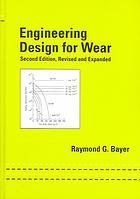

Most ebook files are in PDF format, so you can easily read them using various software such as Foxit Reader or directly on the Google Chrome browser.
Some ebook files are released by publishers in other formats such as .awz, .mobi, .epub, .fb2, etc. You may need to install specific software to read these formats on mobile/PC, such as Calibre.
Please read the tutorial at this link. https://ebooknice.com/page/post?id=faq
We offer FREE conversion to the popular formats you request; however, this may take some time. Therefore, right after payment, please email us, and we will try to provide the service as quickly as possible.
For some exceptional file formats or broken links (if any), please refrain from opening any disputes. Instead, email us first, and we will try to assist within a maximum of 6 hours.
EbookNice Team

Status:
Available4.4
15 reviews
ISBN 10: 0824747720
ISBN 13: 9780824747725
Author: R G Bayer
1 Design Perspective of Wear Behavior
1.1. Introduction
1.2. System Nature of Wear
1.3. Basic Mechanisms of Wear
1.4. Mild and Severe Wear Behavior
1.5. Operational Categories of Tribosystems
1.6. Two-Body Tribosystems
1.7. One-Body Tribosystems
1.8. Materials and Wear Behavior
References
2 Engineering Models for Wear
2.1. Introduction
2.2. Wear and Wear Rate Relationships for Sliding Wear
2.3. Wear and Wear Rate Relationships for Abrasive Wear
2.4. Zero Wear and Measurable Wear Models for Sliding
2.5. Percussive Impact Wear Models
2.6. Model for Rolling Wear
2.7. Model for Ball and Roller Bearing Wear
2.8. Models for Journal Bearing Wear
2.9. MODELS FOR EROSIVE WEAR
2.10. Models for Tool Wear
References
3 Wear Design
3.1. General
3.2. System Analysis
3.3. Model Selection and Development
3.4. Database Identification and Development
3.5. Verification
3.6. Design Triage
References
4 Design Guidelines
4.1 Introduction
4.2. Guidelines
4.2.1. Reliance on Analytical Design Methods Increases the Degree of Conservatism Required
4.2.2. Wear is a System Property; Utilize All Design Parameters That Can Influence Wear
4.2.3. Approach Extrapolation of Data and Extension of Designs Cautiously
4.2.4. Design with Limits and Characteristics of Materials in Mind
4.2.5. Metals and Polymers Tend to Require Different Designs
4.2.6. Design So That a Mild Wear Condition Exists
4.2.7. A Minimum Requirement for Material Selection is That the Material Should be Stable in the Operating Environment
4.2.8. While Fluid or EHD Lubrication is very Effective for Reducing Wear, Specific Designs are Required to Insure this Form of Lubrication
4.2.9. Minimize Exposure to Abrasive Particles
4.2.10. In Abrasive Situations Make the Wear Surfaces Harder than the Abrasives
4.2.11. Optimize Contact Geometry to Minimize Stresses
4.2.12. Use a Lubricant Whenever Possible
4.2.13. Use Dissimilar Materials
4.2.14. Increasing Hardness Tends to Reduce Wear
4.2.15. To Increase System Life (Reduce System Wear), It is Sometimes Necessary to Increase the Hardness of Both Members
4.2.16. Rolling is Preferred Over Sliding
4.2.17. Sliding or Fretting Motions Should be Eliminated in Impact Wear Situations
4.2.18. Compound Impact Situations Can Often be Treated as a Sliding Wear Situation in Which the Loads (Stresses) are Determined by the Impact
4.2.19. Impacts Should be Avoided in Sliding and Rolling Contacts
4.2.20. Elastomers Frequently Outperform Harder Materials and Reduce Counterface Wear in Impact Situations
4.2.21. Thicknesses of Conventional Coatings Generally Should be Greater than 100 µm
4.2.22. Use Moderate Surface Roughnesses
4.2.23. Avoid the Use of Stainless Steel Shafting with Impregnated Sintered Bronze Bearings
4.2.24. When Molded Filled Plastics Tend to Exhibit Significantly Different Initial and Long-Term Wear Behavior
4.2.25. When Glass or Other Hard Fillers are Used, the Hardness of the Counterface Should be Equal to or Greater than that of the Filler
4.2.26. The Tendency for Galling to Occur can be Reduced by Using Dissimilar and Hard Materials of Low Ductility, Lubrication, and Rougher Surfaces
4.2.27. Avoid the Use of Designs in Which Fretting Motions Can Occur
4.2.28. When Fretting Motions are Present, Design to Optimize Sliding Wear Life and to Minimize Abrasive Wear
4.2.29. Sacrificial Wear Design Should be Considered an Option When Satisfactory Life Cannot be Achieved with Available Materials
4.2.30. Conform to Vendor Recommendations Regarding Optimum Wear Performance
4.2.31. Changes Associated with Design Modifications or New Applications Should be Reviewed Carefully with Respect to their Potential Effect on Wear Behavior
4.2.32. Provide Adequate Clearance in Journal Bearings
4.2.33. The Severity of the Wear (Wear Rate) in Rolling, Sliding, and Impact Wear Situations can Generally be Correlated to the Ratio of Operating Stress Over Yield Stress (Stress Ratio)
4.2.34. Design so that Severe Wear Mechanisms Associated with Adhesion and Single-Cycle Deformation do not Occur
5 Design Examples
5.1. Introduction
5.2. Printer Cartridge
5.3. Vacuum Probe
5.4. Forms Thickness Control
5.5. Plastic Gears
5.6. Type Carrier Backstop
5.7. Thermal Conduction Module
5.8. Hammer Pivot
5.9. Band-Platen Interface
5.10. Push Rod Tip
5.11. Band-Ribbon Interface
5.12. Magnetic Read Head
5.13 Erosion Applications
5.14. Abrasion Applications
5.15. Nuclear Valve
5.16. Plug Valve
5.17. Screwnut-Spindle
5.18. Cardan Joint
5.19. Electromagnetic Clutch
References
6 Problem Solving Methodology
6.1. General
6.2. Failure Analysis
6.3. Hypothesis Development
6.4. Testing
References
7 Problem Solving Case Studies
7.1. Introduction
7.2. Card Edge Connector Fretting
7.3. Excessive Carrier Backstop Wear
7.4. Push Rod Tip Failure
7.5. Separator Roll
7.6. Motor Brush Life
7.7. Memory Disk Drive Failures
7.8. Erosion in Fans and Blowers
7.9. Hydraulic Structure Wear
7.10. Teeter Bearing Wear
engineering wears
a design engineer
mechanical engineering wear
an engineering student designed a loop for a roller coaster
b-wear designs
Tags: R G Bayer, Engineering design, wear